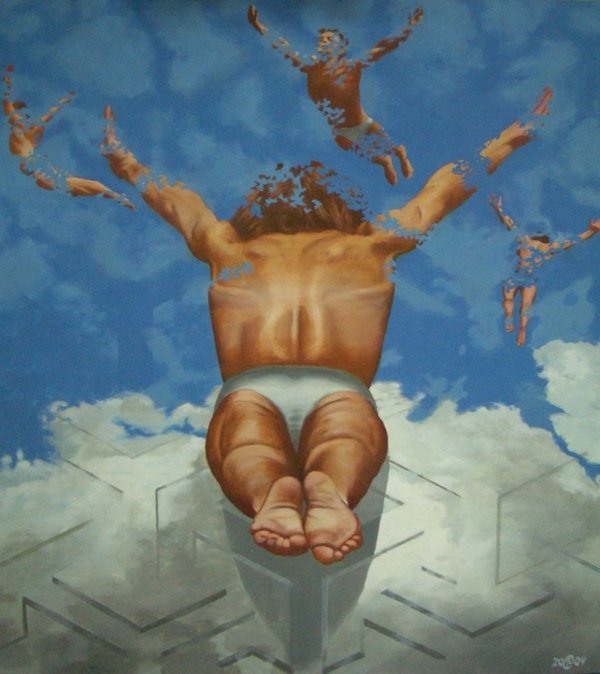Etude to Art Object
dal 12/2/2009 al 9/5/2009
Segnalato da
AES+F
Alexander Archipenko
Konstantin Batynkov
Leonid Borisov
Pavel Chistyakov
Semyon Faibisovich
Andrey Goncharov
Eduard Gorokhovsky
Andrey Grositsky
Francisco Infante
Vyacheslav Koleychuk
Valery Koshlyakov
Oleg Kulik
Mikhail Larionov
Igor Makarevich
Kazimir Malevich
Tatyana Nazarenko
Timur Novikov
Viktor Pivovarov
George Pousenkoff
Leonid Purygin
Oskar Rabin
Aidan Salakhova
Vasili Shukhaev
Sergey Shutov
Igor Snegur
Vinogradov and Dubosarsky
Dmitry Zhilinsky
Anna Arutunian
12/2/2009
Etude to Art Object
Moscow Museum of Modern Art - Petrovka, Moscow
A new experimental display marking the 10th anniversary of the Moscow Museum of Modern Art. The display consists of more than three hundred works executed in various media: from traditional painting, graphics, sculpture and photography to kinetic objects and video installations. In direct proximity, artists are arrayed who often seem to stand at polar extremities in terms of their creative intentions. Among them are: AES+F, Alexander Archipenko, Konstantin Batynkov, Leonid Borisov, Pavel Chistyakov, Semyon Faibisovich, Andrey Goncharov, Eduard Gorokhovsky, Andrey Grositsky, Francisco Infante and many others.

curated by Anna Arutunian
The main building of the Moscow Museum of Modern Art at 25 Petrovka Street is hosting “Étude to Art Object”, a large-scale experimental display focused on works by Russian artists from the Museum’s permanent collection. For the first time ever, the Museum exhibits its holdings united by a single thematic program that allows demonstrating a considerable variety of artworks assembled by the Museum and unveil a number of pieces unseen by the public.
The main reference point of the project is étude, or study. In the strict sense of the word, it is a “subordinate” type of visual art that is executed from nature with a goal of learning its rules. To this day, étude plays a crucial role in academic fine arts education. To match the traditional notion of étude with pioneering practices of contemporary art – here lies the main intrigue of the “Étude to Art Object” display. In this case, étude is a metaphor for a distinctive creative method of the artist, which aims at exploring not only really existing objects, but conceptual features as well. The novelty of curatorial approach consists in a wider interpretation of the étude phenomenon, in its understanding as a flexible and many-sided aesthetic category that can be applied both to preparatory sketches and to finished works of art.
The versatile Museum collection and the thoroughly planned itinerary of the display make it possible to trace how certain traits of étude reveal themselves in the contradictory world of the 20th and 21st-century art. Among these traits are: photographic verisimilitude, repetition of motifs, references to classical tradition, demonstration of laws of motion, the issue of artistic language as such, etc.
The route of the intellectual journey through the display is logically structured by three general thematic sections: “Canon”, “Natura” and “Metamorphoses”. The first section presents model examples of étude, such as graphic studies and academic paintings. In the next zone, the notion of the étude
receives a broad interpretation: works that are on view here may belong to different genres, but all of them explore nature and its principles. Finally, the visitor enters into the space of play and fantasy, where the very idea of the étude is splintered into several conceptual aspects summarized in certain tag-words. Accordingly, the “Metamorphoses” section includes six consecutive parts: “Hyper-reality”, “Repetition”, “Classics!”, “Motion Mechanics”, “Geometry of Form”, and “Language Exercises”. All these aspects, illustrated by works from the Museum’s holdings, reveal at times surprising affinity with dominant interests of contemporary artists.
The display consists of more than three hundred works executed in various media: from traditional painting, graphics, sculpture and photography to kinetic objects and video installations. In direct proximity, artists are arrayed who often seem to stand at polar extremities in terms of their creative intentions. Among them are: AES+F, Alexander Archipenko, Konstantin Batynkov, Leonid Borisov, Pavel Chistyakov, Semyon Faibisovich, Andrey Goncharov, Eduard Gorokhovsky, Andrey Grositsky, Francisco Infante, Vyacheslav Koleychuk, Valery Koshlyakov, Oleg Kulik, Mikhail Larionov, Igor Makarevich, Kazimir Malevich, Tatyana Nazarenko, Timur Novikov, Viktor Pivovarov, George Pousenkoff, Leonid Purygin, Oskar Rabin, Aidan Salakhova, Vasili Shukhaev, Sergey Shutov, Igor Snegur, Vinogradov and Dubosarsky, Dmitry Zhilinsky, and many others.
Apart from works from the collection of the Moscow Museum of Modern Art, the display is enriched with pieces from the Research Museum of the Russian Academy of Arts in St. Petersburg and the Surikov Moscow State Academic Arts Institute.
The design of the display was created by Boris Bernaskoni, one of the most promising young architects in Moscow, praised for his singular approach to exhibition architecture. His stylish and purist solution, without distracting attention from the artworks on view, helps to clarify the structure of the project and guides the visitor on the way from “Étude to Art Object”.
Architecture: Bernaskoni Bureau
Image: E. Gorohovsky. To the Edge of Coarse and Fine, 2004.
Opening: February 13, 2009, 6pm
Moscow Museum of Modern Art
25, Petrovka Street - Moscow



